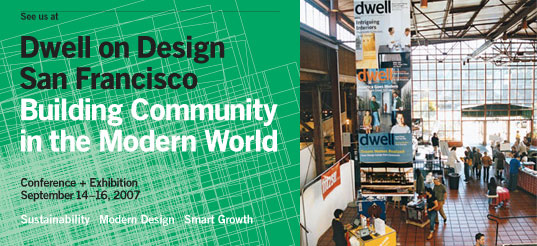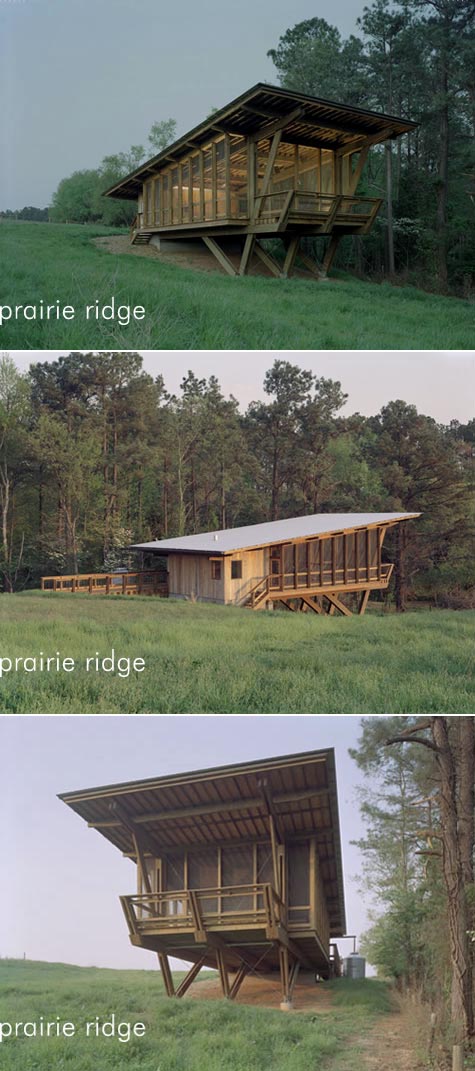Sci-Fi Regionalism
Yesterday was another good day at Dwell on Design, with a handful of talks in the morning followed by more general mingling in the exhibition space all afternoon.
 North Carolina-based architect Frank Harmon – behind the exquisite Prairie Ridge Eco Station, pictured below, designer of Duke University's Smart House, and architect of many, many other great projects – gave the final speech of the conference, presenting his firm's work in the context of "new regionalism."
North Carolina-based architect Frank Harmon – behind the exquisite Prairie Ridge Eco Station, pictured below, designer of Duke University's Smart House, and architect of many, many other great projects – gave the final speech of the conference, presenting his firm's work in the context of "new regionalism."
 [Images: The Prairie Ridge Eco Station, an open air classroom designed by Frank Harmon].
[Images: The Prairie Ridge Eco Station, an open air classroom designed by Frank Harmon].
Frank talked about the use of local materials; how to survive humidity, thunderstorms, summer dry spells, and the harsh winter cold without using electricity, putting architecture itself to use as a local climate modification system; and, finally, the blending of traditional design styles with what could be called global architectural modernism. He showed us a church, a pottery museum, the aforementioned Prairie Ridge Eco Station, an ironworkers' studio, and a few other of his firm's own projects.
One of the most interesting sequences of images he showed was a quick sketch describing the sinusoidal shape of local wind patterns over the North Carolina landscape – which he then clicked away from to reveal the wing-like angled slope of a roof he'd designed to fit into the local windscape almost perfectly.
It's hard to exaggerate how exciting I find that sort of thing.
In any case, Frank Harmon's work is well worth checking out in more detail – and a great Q&A with him is coming up in a future issue of Dwell (where, in full disclosure, I now work) – so here's his website.
But I wanted to follow up here with a few other quick thoughts – because I was on a panel with Frank after his talk, alongside Gwynne Pugh, Lorcan O'Herlihy, and Reed Kroloff, and in the spotlit glare of being on stage I might have been a tad less articulate than I'd hoped to be.
Briefly, then, I mentioned a climate map, published earlier this summer, in which Europe has been re-mapped according to what its regional climates will be like in the year 2071 A.D.
 The map is initially quite confusing, but it shows that London will have the climate of Lisbon, Portugal; Berlin will have the climate of northern Algeria (!); and Oslo will feel like Barcelona (and so on).
The map is initially quite confusing, but it shows that London will have the climate of Lisbon, Portugal; Berlin will have the climate of northern Algeria (!); and Oslo will feel like Barcelona (and so on).
So the question I wanted to propose to the other speakers was: how can architects account for these sorts of wild fluctuations in both weather and climate through architectural design? How can a building be prepared – structurally, materially – for future climate change?
Or, more relevant to Frank Harmon's presentation, especially in the context of "new regionalism": what if you build a house that's perfect for North Carolina as North Carolina now exists – but what happens to that house in, say, twenty years' time, when North Carolina is more like Houston, Texas, or even like Key West?
In which case, what about the new, modern, glass-walled housing stock of Berlin when it finds itself baking in Algiers-like desert temperatures? (How I would love to see sand dunes rolling through the streets of Berlin!)
This, if anything, is the real new regionalism: a regionalism that includes future transitions so out of the ordinary that they verge on science fiction.
It's sci-fi regionalism – architectural design in an era of global climate change.
 North Carolina-based architect Frank Harmon – behind the exquisite Prairie Ridge Eco Station, pictured below, designer of Duke University's Smart House, and architect of many, many other great projects – gave the final speech of the conference, presenting his firm's work in the context of "new regionalism."
North Carolina-based architect Frank Harmon – behind the exquisite Prairie Ridge Eco Station, pictured below, designer of Duke University's Smart House, and architect of many, many other great projects – gave the final speech of the conference, presenting his firm's work in the context of "new regionalism." [Images: The Prairie Ridge Eco Station, an open air classroom designed by Frank Harmon].
[Images: The Prairie Ridge Eco Station, an open air classroom designed by Frank Harmon].Frank talked about the use of local materials; how to survive humidity, thunderstorms, summer dry spells, and the harsh winter cold without using electricity, putting architecture itself to use as a local climate modification system; and, finally, the blending of traditional design styles with what could be called global architectural modernism. He showed us a church, a pottery museum, the aforementioned Prairie Ridge Eco Station, an ironworkers' studio, and a few other of his firm's own projects.
One of the most interesting sequences of images he showed was a quick sketch describing the sinusoidal shape of local wind patterns over the North Carolina landscape – which he then clicked away from to reveal the wing-like angled slope of a roof he'd designed to fit into the local windscape almost perfectly.
It's hard to exaggerate how exciting I find that sort of thing.
In any case, Frank Harmon's work is well worth checking out in more detail – and a great Q&A with him is coming up in a future issue of Dwell (where, in full disclosure, I now work) – so here's his website.
But I wanted to follow up here with a few other quick thoughts – because I was on a panel with Frank after his talk, alongside Gwynne Pugh, Lorcan O'Herlihy, and Reed Kroloff, and in the spotlit glare of being on stage I might have been a tad less articulate than I'd hoped to be.
Briefly, then, I mentioned a climate map, published earlier this summer, in which Europe has been re-mapped according to what its regional climates will be like in the year 2071 A.D.
 The map is initially quite confusing, but it shows that London will have the climate of Lisbon, Portugal; Berlin will have the climate of northern Algeria (!); and Oslo will feel like Barcelona (and so on).
The map is initially quite confusing, but it shows that London will have the climate of Lisbon, Portugal; Berlin will have the climate of northern Algeria (!); and Oslo will feel like Barcelona (and so on). So the question I wanted to propose to the other speakers was: how can architects account for these sorts of wild fluctuations in both weather and climate through architectural design? How can a building be prepared – structurally, materially – for future climate change?
Or, more relevant to Frank Harmon's presentation, especially in the context of "new regionalism": what if you build a house that's perfect for North Carolina as North Carolina now exists – but what happens to that house in, say, twenty years' time, when North Carolina is more like Houston, Texas, or even like Key West?
In which case, what about the new, modern, glass-walled housing stock of Berlin when it finds itself baking in Algiers-like desert temperatures? (How I would love to see sand dunes rolling through the streets of Berlin!)
This, if anything, is the real new regionalism: a regionalism that includes future transitions so out of the ordinary that they verge on science fiction.
It's sci-fi regionalism – architectural design in an era of global climate change.





Comments are moderated.
If it's not spam, it will appear here shortly!
o! this is really interestin matter. so, maybe the only way to solve this problem is creating mutable, flexible structures to live... : ) /look at the comments to "well-behaved homes/
It is a very good thing when site placement is considered. Adding a building will change the local environment creating a micro-climate. Build -to- the new climate, not to what existed prior to construction.
Not quite Lisbon, but Oporto, Portugal.
I love the theme and form of the prairie ridge building.
I'm working on something similar.
The buildings built for the colder climates should have no problems adapting to the hotter climate. The hot climate, just like the cold, needs insulation.
Now if you are talking about making buildings that rely on natural cooling/heating which would be tailored towards one specific climate, then yes, you should be worried.
entrenched housing imo.
and if the world ends, your house will serve as a nice grave.
Post a Comment